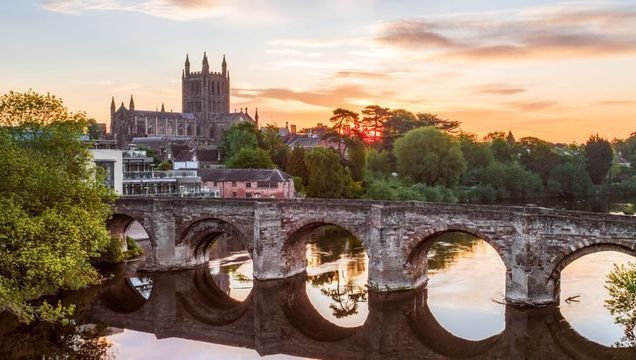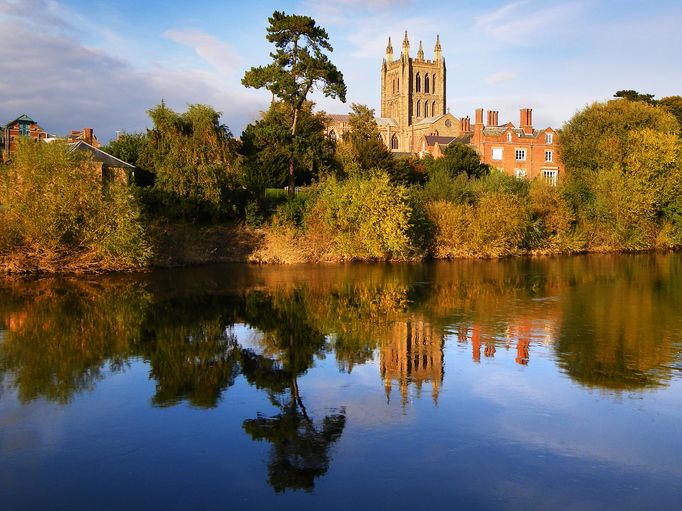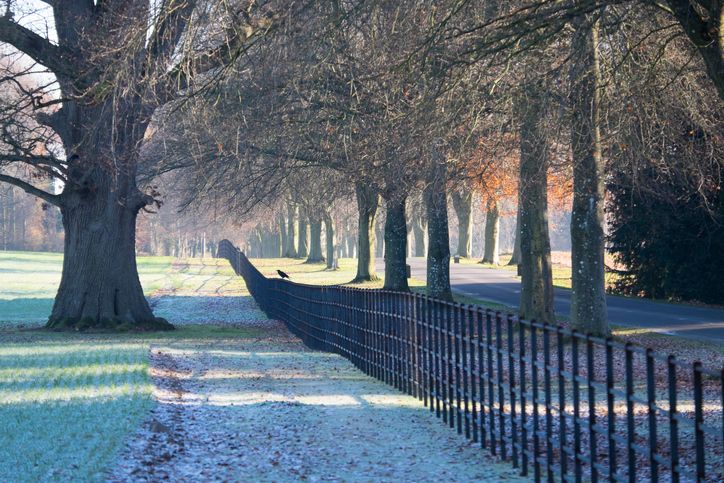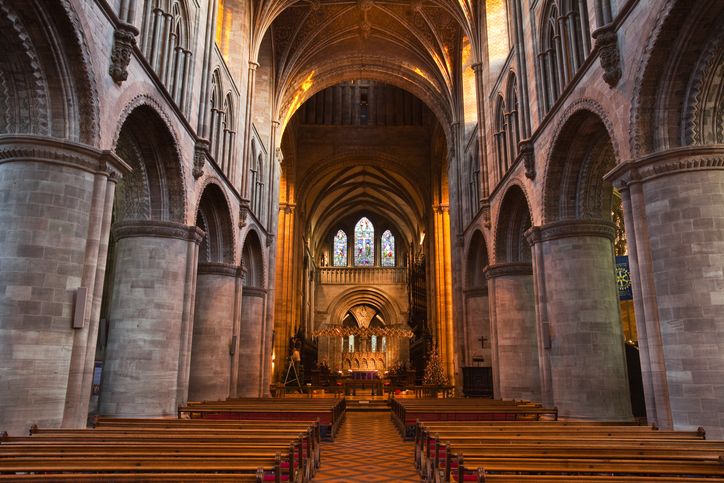
River Wye, Old Roman Bridge and Cathedral, Hereford, Herefordshire, England.Getty
Just what we imagine a small cathedral city ought to be.
Running north and south along the border between Wales and England, roughly following the route of the 8th-century earthwork wall called Offa’s Dyke, the Welsh Marches (or just The Marches) offer a visit far removed from the urban multicultural world of contemporary England.
This is the timeless England of our memory and imagination.
In the southern Marches, all roads lead to Hereford. Cathedral city and county town of Herefordshire, Hereford (population 50,000) straddles the River Wye, where it was at the heart of contested land between the Welsh princes and the Anglo-Saxon newcomers as far back as the 7th century.
Today, the lively city embodies what we think a provincial cathedral city ought to be.
Read more: The port of Manchester

Reflection of Cathedral in river Wye, Hereford.
Making Your Way
From London or the airports, take the M40 to Oxford. Travel west across the northern Cotswolds on the A40 through Cheltenham and Gloucester; from Oxford it’s roughly a 90-minute drive to Ross-on-Wye. Follow the A49 north with the winding river to Hereford.
Yes, Hereford’s easily accessible by rail. That’s a train from London Paddington to Newport or Cardiff and a change to the Welsh Marches Line (www.nationalrail.co.uk). It’s an easy morning ride.
A room of one’s own
Just outside the cathedral close, Castle House is the premier center city hotel. A classic coaching inn near the market square, The Green Dragon shows some wear and tear, but comes at a lower rate and includes plenty of atmosphere.
Contemporary budget options, Premier Inn and Travelodge are dependable choices on the city’s edge.
Pay a call at the Discover Herefordshire Centre on 1 King St, just across the street from the cathedral. Besides supplying the usual maps, guides and event information, they would be happy to coach on the many other accommodation options in the neighborhood. In addition to visitor information, the Centre showcases local crafts, books and vintage collectibles.

Photo Taken In Hereford, United Kingdom
Read more: 125 Years of Tower Bridge
Hitting Hereford’s highlights
Predictably, 12th-century Hereford Cathedral forms the city’s center point and highlight. Though Hereford’s roots as the seat of a bishopric go back to the 600s, the present cathedral was begun in 1079.
Alterations to the Norman church over the centuries have hardly dimmed its medieval majesty. Join choral evensong at 5:30 p.m. to hear the Cathedral Choir lift the Psalms and anthem into the vast stone nave.
The cathedral’s greatest treasure is the 13th-century Mappa Mundi. The largest medieval world map in existence, its intricate illustrations not only reflect the world as it was conceived in the 1200s but provide commentary on its times as well.
Hereford Cathedral’s chained library dates from the early 1600s when across Europe the value of books was reflected by this state-of-the-art security system. Today, the virtually intact library of some 1,500 volumes is the largest such surviving example. It sits in a climate-controlled environment to protect 229 medieval manuscripts—and the 8th-century Hereford Gospels.

Hereford Cathedral dates from 1079. It is home to Mappa Mundi, which is a medieval map of the world dating from the 13th century.
Right in the neighborhood
Take a short ride through the Golden Valley to browse the book town of Hay-on-Wye. Explore the nearby Forest of Dean, with great visits at Clearwell Caves, Goodrich Castle, and the Dean Heritage Centre: Victorian cottage to charcoal burner’s camp. Do keep an eye out for wild boar. Or toddle a few miles east to Ledbury for a visit to the Georgian mansion of Eastnor Castle.
Move on - In any direction
To the West lie the Brecon Beacons; return to Ross-on-Wye to continue on the A40 “Top of the Valleys” road across the South Wales coal valleys. Or travel north on the A49 through The Marches: surviving bits of Offa’s Dyke, fertile farmland and orchards, the culinary mecca of Ludlow and on to Shropshire’s county town of Shrewsbury. Or continue north by train to Shrewsbury and return from there to London. To the south, follow the Wye through Symonds Yat to Monmouth, Tintern Abbey, and Chepstow.
Read more: Exploring the fens





Comments